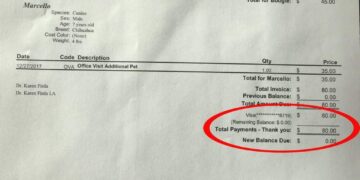Table of Contents
The Agony of the Aisle: A Dog Owner’s Dilemma
The scene is a familiar one for any dog owner: standing in the fluorescent-lit expanse of a pet food aisle, confronted by a wall of choices that induces a unique form of paralysis. On one side, a colossal bag, its plastic shell bursting with primary colors and cartoonish images of happy dogs, boasts a price that seems almost too good to be true—less than $0.85 per pound, cheaper than a morning latte.1 On the other side, sleek, matte-finish bags with minimalist designs whisper promises of ancestral diets, wild-caught salmon, and farm-fresh vegetables, their premium price tags reflecting their aspirational marketing. In the chasm between these two extremes lies a minefield of confusion, guilt, and nagging questions. The desire to provide the absolute best for a beloved companion clashes violently with the practical, unyielding constraints of a household budget.
This report seeks to reframe this agonizing choice. The goal is not to find the “best cheap dog food,” a term that is, in itself, a paradox. The cheapest options are often inexpensive for reasons that directly compromise a dog’s long-term health, making them a poor value proposition. Conversely, the most expensive foods are not always inherently superior and may be priced based on marketing rather than nutritional science. The true objective, therefore, is to find the best value: the highest quality, most nutritionally sound food that is realistically affordable. This investigation is built on a foundational premise echoed by veterinarians and nutrition experts alike: the money saved on a bargain-bin food is often spent later, sometimes tenfold, on veterinary bills to treat the very conditions that poor nutrition can cause.2
To make the abstract concept of canine nutrition immediately tangible, it is useful to employ a simple yet powerful analogy. The most inexpensive, mass-market kibbles are the canine equivalent of human junk food. They are the greasy burgers, the sugary sodas, and the processed snacks of the dog world.3 While a single fast-food meal is unlikely to cause lasting harm, a diet consisting of nothing else, day after day, year after year, inevitably takes a toll. This report will serve as an in-depth guide for the conscientious owner, pulling back the curtain on how these “junk foods” are made, empowering them with the knowledge to read labels like a detective, and ultimately, providing a clear, actionable playbook for navigating the aisle with confidence and choosing a food that supports a long, vibrant, and healthy life for their dog.
Behind the Colorful Bag: The True Cost of Bargain-Bin Kibble
The remarkably low price of the cheapest dog foods is not a result of manufacturing magic or corporate benevolence; it is the direct outcome of a specific formulation strategy centered on minimizing cost at every stage of production. This strategy relies on a trifecta of low-quality ingredients, aggressive processing techniques, and a cocktail of artificial additives that, while keeping the price down, can systematically undermine a dog’s health over time. Understanding this process is the first step in recognizing why the sticker price is a dangerously incomplete measure of a food’s true cost.
The Trifecta of Poor Quality
The architecture of a bottom-tier kibble is remarkably consistent across brands. It is a formula designed not for optimal nourishment, but for creating a palatable, shelf-stable product that meets the bare-minimum legal requirements as inexpensively as possible. This is achieved through three primary pillars.
The Filler Façade – Bulking Up on a Budget
An inspection of the ingredient panel on the cheapest dog foods reveals a telling pattern: meat is rarely the first ingredient.1 Instead, the top spots are occupied by inexpensive, high-starch grains and legumes like corn, wheat, and soy.2 These ingredients serve as “fillers,” providing bulk, texture, and a cheap source of calories and plant-based protein to make dogs feel full at the lowest possible cost.3
While these ingredients are not toxic in and of themselves, their dominance in a formula presents significant nutritional problems. They are generally less digestible for dogs than animal-based ingredients and offer limited nutritional value beyond their carbohydrate content.1 This high-carbohydrate load is quickly converted into sugar in a dog’s body. If not immediately used for energy, it is stored as fat, creating a direct pathway to weight gain and obesity.2 Canine obesity is a serious concern, dramatically increasing the risk for a host of secondary conditions, including diabetes, heart disease, and debilitating joint problems.2
Specific fillers common in these foods present their own issues. Ground yellow corn, a frequent headliner, has a relatively high glycemic index and low comparative nutritional value.1 Soybean meal, another common filler, contains anti-nutritional factors that can interfere with digestion and has been shown to cause gastrointestinal discomfort and low-quality stools.1 Some labels even list “wheat middlings,” a low-quality byproduct from flour mills that is essentially the sweepings off the factory floor, offering even less nutritional value than ground wheat.1 Furthermore, these grains are among the most common food allergens in dogs, and a diet high in them can trigger symptoms ranging from chronic itching and ear infections to severe gastrointestinal distress.2
The Mystery Meat – A Question of Protein
The second pillar of cheap kibble is the use of low-quality, ambiguously sourced protein. Dogs are not obligate carnivores like cats, but they thrive on high-quality animal protein, which provides the essential amino acids critical for muscle development, organ function, and overall health.2 The cheapest foods cut costs dramatically by using inferior protein sources that are a world away from the whole, deboned chicken pictured on the front of the bag.
These ingredients appear on labels under vague, unsettling names like “meat and bone meal” (MBM), “animal by-products,” and “animal digest”.2 “Meat by-products” are the non-rendered, clean parts, other than muscle meat, left over after an animal has been processed for human consumption; this can include lungs, spleen, kidneys, and bone.2 While not inherently harmful, they are subjected to extensive processing that diminishes their nutritional value, leaving behind proteins that are less digestible and deficient in key amino acids.2
“Meat and bone meal” is a far more dubious ingredient. It is a product of the rendering industry, a process that involves cooking animal tissues at extreme temperatures to separate fat and remove moisture. The raw materials for MBM can include the offal and bones of slaughtered livestock, but they can also legally include unsellable retail meat, fat from unmarketable tissues, and even whole condemned carcasses from animals that were diseased or died before slaughter.1 The only parts legally excluded are hair, blood, hooves, horns, and the contents of the digestive tract.1 The resulting powder is a concentrated protein source, but its digestibility and nutritional quality are highly variable and often poor.6
The intense, ultra-high heat required for rendering is necessary to sterilize this material, but it also destroys heat-sensitive vitamins, enzymes, and other beneficial nutrients.7 What remains is a shelf-stable powder, but one that has been stripped of much of its original biological value.2 A further problem is the anonymity. When a label says “meat meal” or “animal fat” instead of “chicken meal” or “chicken fat,” the source is unknown.6 This makes it impossible for an owner to identify the cause of a potential food allergy and raises questions about the consistency and quality of the ingredients from one batch to the next.
The Chemical Cocktail – Additives, Dyes, and Preservatives
The final pillar is the reliance on artificial additives to make the product palatable, colorful, and shelf-stable. After being subjected to high-heat processing, the slurry of fillers and rendered meal is neither appetizing nor visually appealing. To compensate, manufacturers add a host of synthetic chemicals.1
- Artificial Preservatives: To prolong shelf life, budget foods often rely on chemical preservatives like butylated hydroxyanisole (BHA), butylated hydroxytoluene (BHT), and ethoxyquin.2 This is a significant health concern, as multiple studies have identified BHA and BHT as carcinogens, linked to an increased risk of cancer in animals.2 Ethoxyquin, a preservative also used as a pesticide and rubber hardener, has been associated with liver damage and other health issues in animals.2
- Artificial Colors and Dyes: The rainbow of colors found in some cheap kibbles—the reds, greens, and yellows—serves no purpose for the dog, who experiences the world primarily through scent and cares little about the color of its food.3 These dyes are added solely to appeal to the human consumer, creating the illusion of a varied meal containing meats and vegetables.11 Common dyes like Blue 2, Red 40, and Yellow 5 and 6 have been linked to allergic reactions and hyperactivity.4
- Flavor Enhancers and Sweeteners: To make the bland base ingredients more palatable, manufacturers often add flavor enhancers like “animal digest”—a soupy broth made from the chemical or enzymatic breakdown of unspecified animal tissues.5 Some brands go a step further, adding sweeteners like corn syrup.1 Corn syrup provides no nutritional benefit and is included only to make the food more addictive to dogs. Much like in humans, a diet with added sugar can lead directly to obesity and diabetes.1
The Domino Effect: From Poor Ingredients to Poor Health
The combination of these three pillars—low-quality fillers, mystery meat proteins, and a cocktail of artificial additives—creates a cascade of potential health problems that can manifest over a dog’s lifetime. The poor digestibility of the ingredients can wreak havoc on the gastrointestinal tract, leading to chronic gas, bloating, diarrhea, and constipation.2 The presence of common allergens and artificial additives can trigger persistent skin conditions, such as dermatitis, incessant itching, hair loss, and recurrent ear infections.2
The nutritional deficiencies inherent in these formulas can have more insidious, long-term consequences. A lack of high-quality, bioavailable vitamins and antioxidants can weaken the immune system, leaving a dog more susceptible to infections and slowing its recovery from injury or surgery.2 A deficiency in taurine, an amino acid found in high-quality animal proteins, has been directly linked to a serious heart condition called dilated cardiomyopathy (DCM) in certain breeds.2 The lack of sufficient omega-3 fatty acids can also compromise cardiovascular health.2
This cascade of poor health inevitably translates into a significant financial toll. The savings realized at the checkout counter can be quickly erased by the cost of veterinary care. An episode of diet-related colitis can run upwards of $200.3 Managing a diabetic dog with insulin can cost $200 per month or more.3 And treating chronic kidney disease—a condition exacerbated by highly processed, high-sodium diets—can cost thousands of dollars a month in specialized care and prescription diets.3 This stark financial reality powerfully illustrates the central thesis: cheap food is rarely cheap in the long run.
The manufacturing process itself introduces further risks. The reliance on low-quality raw materials necessitates the use of extreme heat for sterilization. This not only destroys nutrients but can also create carcinogens like acrylamides during the cooking process.8 Furthermore, the very nature of dry kibble creates a hidden health stressor. With a moisture content often below 10%, a kibble-only diet can place a dog in a constant state of mild dehydration, putting long-term strain on the kidneys and other vital organs.8 Many of the cheapest foods are made from dry powders to begin with, requiring manufacturers to add “water sufficient for processing” just to form the pellets—a clear indicator of the product’s inherent dryness.1 This chronic dehydration, combined with the other risk factors, creates a perfect storm for the development of serious, and expensive, health conditions.
From Shopper to Sleuth: Becoming Your Dog’s Nutrition Detective
Navigating the pet food aisle need not be an exercise in fear and confusion. By learning to decode the information presented on the package, any owner can transform from a passive consumer into an empowered nutrition detective. This section provides the tools and knowledge necessary to critically evaluate any bag of dog food, moving beyond the marketing hype on the front to the crucial facts on the back. The key is understanding the regulatory landscape and learning to read the “code” hidden in the nutritional adequacy statement and the ingredient list.
The Rule-Maker and the Rules: Understanding AAFCO
The most prominent acronym in the pet food world is AAFCO, which stands for the Association of American Feed Control Officials. It is essential to understand what AAFCO is and, just as importantly, what it is not. AAFCO is a private, voluntary membership association composed of state and federal feed control officials, veterinarians, and scientists.12 Its primary role is to establish standards and guidelines for the nutritional content and labeling of animal feeds, including pet food.13
Crucially, AAFCO does not regulate, test, approve, or certify any pet food product.12 The actual regulation of pet food is handled at the federal level by the U.S. Food and Drug Administration (FDA) and at the state level by individual state feed control officials, who often adopt AAFCO’s model regulations into their own laws.12
The phrase “AAFCO approved” is a common misconception and a marketing myth. When a pet food company uses AAFCO’s name on its packaging, it is making a statement that its product was formulated to meet the nutritional standards set by the organization. This creates a potential pitfall for the uninformed consumer. A manufacturer can use the cheapest fillers and a synthetic vitamin pack to just barely meet the minimum nutrient percentages required by AAFCO, and then legally print the AAFCO statement on the bag.3 A consumer seeing this may believe the food has passed a rigorous quality test, when in fact it has only met a minimum on-paper requirement. This allows a nutritionally inferior product to appear, at a glance, as legitimate as a high-quality, scientifically formulated one.
The Nutritional Adequacy Statement – The Most Important Part of the Label
Despite the potential for misinterpretation, the AAFCO nutritional adequacy statement is the single most important piece of information on a pet food label.16 It is the key that unlocks whether a food is suitable as a primary diet for your pet. This statement, usually found in small print on the back or side panel, must contain specific information.13
- “Complete and Balanced”: This term signifies that the product contains all the nutrients required by a dog in the correct ratios to be used as its sole source of nutrition.13 If a product does not carry this claim, it must be labeled “for intermittent or supplemental feeding only,” which is a red flag indicating it is not a complete meal and is likely a treat, topper, or specialized veterinary diet.12
- Life Stages: Nutrition is not one-size-fits-all. AAFCO recognizes distinct life stages with different nutritional needs.12 The two primary profiles are:
- Growth and Reproduction: Formulated for the higher energy, protein, and mineral needs of puppies and pregnant or nursing female dogs.13
- Adult Maintenance: Formulated for the needs of a healthy adult dog that is no longer growing.13
Some foods are formulated to meet both profiles and will be labeled for “All Life Stages.” It is also important to note that AAFCO has specific guidelines for foods intended for the growth of large-breed puppies (those expected to be over 70 pounds as adults), as their rapid growth rate requires carefully controlled levels of calcium to prevent developmental orthopedic diseases.13 - Substantiation Methods: The statement must also declare how the company substantiated its “complete and balanced” claim. There are two methods 12:
- Formulation Method: The label will state, “[Product Name] is formulated to meet the nutritional levels established by the AAFCO Dog Food Nutrient Profiles for.”. This means the food’s recipe was either calculated on a spreadsheet or analyzed in a lab to ensure it meets the AAFCO nutrient profile on paper. This is the most common method.
- Feeding Trial Method: The label will state, “Animal feeding tests using AAFCO procedures substantiate that [Product Name] provides complete and balanced nutrition for.”. This is considered the gold standard. It means the food was not just formulated to meet the profiles but was actually fed to dogs for an extended period under strict AAFCO protocols to prove that it performs well and is properly digested and utilized by the animals.13
Cracking the Code: A Step-by-Step Guide to the Label
Beyond the AAFCO statement, the rest of the label provides a wealth of information for the discerning detective.
The Product Name Game
The very name of the product is regulated by AAFCO and can give an immediate clue as to its contents.20
- The 95% Rule: If a product is named “Beef Dog Food,” the named ingredient (beef, in this case) must make up at least 95% of the total product weight, excluding water. If water is included, it must be 70%. This rule generally applies only to simple, meat-heavy formulas.
- The 25% Rule (or “Dinner” Rule): If the name includes a qualifier like “Dinner,” “Formula,” “Platter,” or “Entrée” (e.g., “Beef Dinner for Dogs”), the named ingredient(s) must comprise at least 25% of the product, excluding water (10% with water).
- The 3% Rule (or “With” Rule): If the label says “Dog Food with Beef,” it is only required to contain a minimum of 3% beef. This rule is often used to highlight a desirable ingredient that is present in only a small quantity.
- The “Flavor” Rule: A product named “Beef Flavor Dog Food” only needs to contain enough of the ingredient (or an artificial flavor enhancer) for the flavor to be detectable by the animal. It implies no minimum percentage.
The Ingredient List
The ingredient list is a window into the manufacturer’s formulation philosophy and economic priorities. By law, ingredients must be listed in descending order by their pre-processing weight.17 This single rule is the most powerful tool for evaluation. The first few ingredients make up the vast majority of the food. Ideally, the first ingredient should be a specific, named animal protein source, such as “deboned chicken,” “lamb,” or “chicken meal”.11
When reading the list, be aware of two common tactics used to disguise the true composition of the food. The first is the “water weight” of fresh meat. An ingredient like “chicken” sounds appealing, but it is about 70-80% water before cooking. A dehydrated “chicken meal” listed further down the panel may actually contribute more animal protein to the final, cooked kibble.23 The second tactic is “ingredient splitting.” A manufacturer might list “ground yellow corn,” “corn gluten meal,” and “corn syrup” as separate ingredients. If they were combined and listed as “corn products,” they would likely be the first ingredient on the list, ahead of the meat. Splitting them pushes them down the list, making the food appear more meat-rich than it is.
The Guaranteed Analysis (GA)
The GA panel provides the minimum percentages of crude protein and crude fat, and the maximum percentages of crude fiber and moisture.17 The term “crude” simply refers to the specific laboratory method used to estimate these nutrients; it does not reflect the quality or digestibility of the ingredients providing them.21 While the GA provides a basic nutritional snapshot, it is difficult to use for direct comparison between different types of food (e.g., wet vs. dry) without performing a “dry matter basis” calculation to account for the vast difference in moisture content. However, it can be compared against the AAFCO minimums to ensure the food is adequate.
To provide a clear, objective benchmark for evaluation, the following table outlines the key minimum nutritional requirements established by AAFCO for non-large breed dogs.
| Nutrient | Adult Maintenance (min %) | Growth & Reproduction (min %) |
| Crude Protein | 18.0 | 22.5 |
| Crude Fat | 5.5 | 8.5 |
| Calcium | 0.5 | 1.2 |
| Phosphorus | 0.4 | 1.0 |
| Nutrient | Adult Maintenance (max %) | Growth & Reproduction (max %) |
| Calcium | 2.5 | 2.5 |
| Phosphorus | 1.6 | 1.6 |
Source: Data compiled from AAFCO Dog Food Nutrient Profiles.13 All values are on a dry matter basis.
This table serves as an essential reference point. It transforms abstract numbers on a bag into meaningful data. By understanding these minimums, an owner can look at a product’s Guaranteed Analysis and determine if it is merely adequate or robustly formulated, providing a powerful, data-driven tool for making an informed choice.
The Good, The Bad, and The Budget-Friendly: A Brand Showdown
Armed with the ability to decode labels and understand nutritional standards, the pet food aisle transforms from a place of confusion into a field for investigation. This section applies that knowledge directly, moving from theory to practice by analyzing specific, widely available brands. By placing them side-by-side, the vast differences in quality, philosophy, and value become starkly apparent.
The “Red Flag” Ingredient Checklist
Before examining specific brands, it is useful to have a simple, memorable checklist of ingredients that should raise immediate concern. The presence of one or more of these, particularly high on the ingredient list, is a strong indicator of a lower-quality food.
- Artificial Preservatives: BHA, BHT, Ethoxyquin, Propyl Gallate.2
- Vague Protein Sources: “Meat Meal,” “Meat and Bone Meal,” “Animal By-Products,” “Animal Digest”.1
- Artificial Colors & Dyes: Blue 2, Red 40, Yellow 5, etc..4
- Added Sweeteners: Corn Syrup, Sugar.1
- Low-Quality Fillers as a Primary Ingredient: Corn, Wheat, or Soy listed before a named meat source.1
- Other Controversial Additives: Melamine, Carrageenan, Propylene Glycol.3
Case Study: The Bottom of the Barrel
These brands represent the cheapest options on the market. Their formulas are textbook examples of prioritizing cost over nutritional quality, and their ingredient lists are littered with red flags.
- Ol’ Roy: As Walmart’s exclusive store brand, Ol’ Roy is one of the best-selling and cheapest dog foods in the United States.26 An analysis of its “Complete Nutrition” formula reveals ground yellow corn as the first ingredient, followed by soybean meal and the anonymous “meat and bone meal”.6 This composition immediately signals a diet built on inexpensive fillers and a low-quality, vaguely sourced protein. The formula also contains “animal fat” preserved with the carcinogen BHA and lacks beneficial additives like probiotics.6 Unsurprisingly, the brand has been linked to numerous consumer complaints of sick pets, health issues like kidney failure, and was included in recalls for containing the euthanasia drug pentobarbital.26 With a price as low as $0.50 per pound, it exemplifies the adage that you get what you pay for.29
- Pedigree: Another ubiquitous supermarket brand, Pedigree’s “Adult Complete Nutrition” formula follows a similar pattern. Its ingredient list begins with ground whole grain corn, followed by the same anonymous “meat and bone meal”.30 The formula contains multiple red-flag ingredients, including BHA as a preservative, artificial colors, and a high salt content.30 The company itself notes that the ingredients are pet-grade, not human-grade, and the use of by-products and meat meals from unspecified sources raises concerns about quality and safety.30
Case Study: The High-Value Contenders
These brands occupy a slightly higher price point but offer a significantly better nutritional profile. They represent the “best value” segment of the market, where a modest increase in cost yields a substantial improvement in quality.
- Purina One: Frequently recommended in owner forums, Purina One is praised for being an affordable food backed by significant scientific research.32 Unlike the bottom-tier brands, its formulas, such as the “Chicken & Rice” recipe, list a real, named meat (“Chicken”) as the #1 ingredient.33 While the formula does contain corn, its position after the primary protein source marks a critical philosophical difference from filler-first foods. Purina is a company that employs a team of veterinary nutritionists and formulates its diets to meet the stringent guidelines of the World Small Animal Veterinary Association (WSAVA), a key indicator of quality control and scientific rigor that cheaper brands lack.19 At approximately $1.50 per pound, it offers a scientifically backed formulation for a reasonable price.32
- Iams: Another brand with a long history and positive reputation among many owners, Iams is often cited for its affordability and visible results, such as improved coat health.32 The “ProActive Health” line also features real chicken as the first ingredient.35 It is a good, but not perfect, option; the formulas often use “chicken by-product meal” as a secondary protein source, which is a step down from a named meat meal but still superior to anonymous “meat meal”.34 It represents a solid middle-ground choice, providing a meat-first formula at a budget-friendly price point of around $1.40 to $1.55 per pound.32
- Kirkland Signature: The private-label brand from Costco is widely regarded as one of the best values in the entire pet food market.32 Its “Adult Formula Chicken, Rice & Vegetable” recipe boasts an impressive ingredient list for its price. It starts with fresh chicken and chicken meal, followed by whole grain brown rice and cracked pearled barley.24 Notably, it is free of the most common low-quality fillers like corn, wheat, and soy, and contains no by-product meals or artificial preservatives.39 It is also enhanced with beneficial supplements like probiotics for digestive health and glucosamine and chondroitin for joint support.39 Often priced competitively with Iams and Purina One (around $1.30-$1.40/lb in-store), Kirkland Signature represents the pinnacle of the value curve, offering premium-level ingredients at a budget-friendly price.32
It is important to address a common point of confusion: the anecdotal evidence of dogs living long lives on the cheapest foods.41 This phenomenon can be attributed to a combination of factors. First, individual genetics and constitution play a significant role; some dogs are simply more resilient than others.43 Second, this is a classic example of survivorship bias—we hear the success stories, but not from the owners whose pets suffered from chronic, diet-related ailments. Finally, there is a vast difference between merely surviving and actively thriving. A dog on a poor diet may live a long life but suffer from low energy, a dull coat, and chronic inflammation that diminishes its overall quality of life.22 Choosing a higher-value food is not just about avoiding catastrophe; it is about optimizing for vitality. The slightly higher price of a brand like Purina One or Kirkland is not just for better ingredients—it is for the investment in nutritional science, quality control, and formulation expertise that ensures the food is not just minimally adequate, but actively beneficial.
Table: Budget-Friendly Brand Comparison
To synthesize these case studies, the following table provides a direct, at-a-glance comparison of these representative brands. It serves as a practical “cheat sheet” for making an informed decision in the store.
| Brand | Approx. Price/lb | First 5 Ingredients | Primary Protein Source(s) | Contains Red Flag Ingredients? | AAFCO Substantiation |
| Ol’ Roy Complete Nutrition | ~$0.54 29 | Ground Yellow Corn, Soybean Meal, Meat and Bone Meal, Poultry By-Product Meal, Animal Fat 6 | Meat and Bone Meal, Poultry By-Product Meal | Yes (BHA, Anonymous Meat) 6 | Formulation |
| Pedigree Adult Complete Nutrition | ~$0.68 44 | Ground Whole Grain Corn, Meat and Bone Meal, Corn Gluten Meal, Animal Fat, Soybean Meal 30 | Meat and Bone Meal, Chicken By-Product Meal | Yes (BHA, Anonymous Meat, Dyes) 30 | Formulation |
| Purina One Chicken & Rice | ~$1.50 32 | Chicken, Rice Flour, Corn Gluten Meal, Whole Grain Corn, Chicken By-Product Meal 33 | Chicken, Chicken By-Product Meal | No (Contains corn, but after meat) | Formulation |
| Kirkland Signature Chicken, Rice & Veg | ~$1.40 40 | Chicken, Chicken Meal, Whole Grain Brown Rice, Cracked Pearled Barley, Chicken Fat 24 | Chicken, Chicken Meal | No | Formulation |
Note: Prices are approximate and based on the largest available bag sizes from major retailers as of late 2024/early 2025; in-store prices may vary. Ingredient lists are based on representative formulas and may differ slightly between specific product lines.
The Smart Owner’s Playbook: An Action Plan for Affordable Nutrition
The journey from a confused shopper to an empowered nutrition detective culminates in this final section: a practical, actionable playbook. Providing excellent nutrition on a budget is not about a single “right” answer, but about having a flexible strategy. This involves understanding the different tiers of value available and employing smart tactics that go beyond simply choosing a bag of food.
The Tiered Approach to Budget Feeding
Recognizing that every owner’s financial situation is different, a “Good, Better, Best Value” framework can help guide decisions based on what is realistically achievable.
- Good: For those on the tightest of budgets, the absolute priority is to avoid the bottom-of-the-barrel store brands with anonymous ingredients and known carcinogens. Instead, opting for a research-backed entry-level brand from a major manufacturer like Purina is a safer choice. Formulas like Purina Dog Chow (at ~$0.73/lb) or Beneful (at ~$1.09/lb) still rely heavily on corn and by-products, but they are formulated by a company with a deep investment in nutritional science and quality control, which is a significant advantage over brands with opaque sourcing and questionable safety records.32
- Better: The next step up, which offers a substantial nutritional improvement for a modest price increase, includes brands like Purina One (~$1.50/lb) and Iams (~$1.55/lb).32 The key differentiator at this tier is that a named, real meat is the first ingredient. This ensures the food is built around a foundation of quality animal protein rather than cheap fillers, providing a more bioavailable and nutritionally complete meal for your dog.
- Best Value: For owners who have access to a wholesale club, brands like Costco’s Kirkland Signature represent the peak of the value curve. They offer ingredient profiles that rival many premium, high-priced brands—with named meats as the primary ingredients and no corn, wheat, or soy fillers—but at a price point that is often competitive with or even lower than the “Better” tier brands.24 This tier delivers the most nutritional bang for your buck.
Beyond the Bag: Smart Supplementation and Savvy Shopping
The kibble in the bowl is only part of the equation. Several strategies can be used to both enhance the nutritional value of a budget-friendly food and reduce its overall cost.
The Power of Toppers
One of the most effective ways to elevate a “Good” or “Better” kibble is through the addition of inexpensive, healthy toppers. This strategy boosts nutrition, adds critical moisture, and increases palatability, often at a minimal cost.
- Create a “Broth”: Many owners report great success by simply mixing a spoonful of quality canned food with warm water and pouring it over the dry kibble.32 This not only adds flavor that entices picky eaters but also helps combat the chronic low-grade dehydration associated with a kibble-only diet.8
- Incorporate Healthy Leftovers: Rather than scraping plates into the trash, small amounts of unseasoned, dog-safe leftovers can be a fantastic supplement. Cooked lean meats, plain rice, and certain vegetables can add a fresh, whole-food boost to a processed diet.
- Add Vegetables: Simple, inexpensive vegetables can be a great source of fiber and micronutrients. Lightly cooked or pureed carrots, green beans, and cabbage are excellent, easily digestible additions that many dogs enjoy.45 Some dogs even enjoy frozen raw carrots as a healthy, teething-friendly chew.45
The Economics of Feeding
Smart shopping habits can significantly lower the long-term cost of feeding your dog.
- Buy in Bulk: For dry food, the largest available bag size almost always offers the lowest cost per pound.32 While the upfront cost is higher, the savings over time can be substantial.
- Calculate Cost-Per-Feeding, Not Cost-Per-Bag: This is a critical mindset shift. Higher-quality foods are typically more nutrient- and calorie-dense. This means the recommended serving size is often smaller than that of a cheap, filler-laden food.41 A $50 bag that requires you to feed 2 cups per day may actually be cheaper in the long run than a $35 bag that requires 4 cups per day. Always check the feeding guidelines on the package.
- Hunt for Deals and Discounts: Be proactive in seeking out savings. Many pet stores offer loyalty programs that provide discounts or free products after a certain number of purchases. Signing up for auto-ship services from online retailers often comes with a 5-10% discount on every order.41 Additionally, keeping an eye out for manufacturer coupons, both online and in-store, can help shave dollars off each purchase.38
Conclusion: The Confident Choice
Let us return, finally, to the owner standing in the pet food aisle. The wall of bags no longer seems so intimidating. The paralysis has been replaced by purpose. They are no longer a passive consumer swayed by bright colors or lofty marketing claims; they are an empowered detective, armed with knowledge.
They can walk past the bargain-bin bags, understanding that the low price conceals a high risk of long-term health problems and veterinary bills. They can confidently turn any bag over, bypassing the marketing on the front to analyze the crucial information on the back. They know to look for the AAFCO nutritional adequacy statement first, ensuring the food is “complete and balanced” for their dog’s specific life stage. They can scan the ingredient list, immediately identifying a named meat source as the first ingredient as a sign of quality and flagging anonymous “meat meals” and artificial preservatives as red flags.
They have a strategy. They know the tiers of value, from the safe-bet budget brands to the high-value champions. They understand that they can elevate a good kibble with healthy, inexpensive toppers and that smart shopping can make even better food more affordable. The guilt and confusion have vanished, replaced by the quiet confidence that comes from making an informed decision. The ultimate takeaway is a powerful one: providing excellent, life-sustaining nutrition for a beloved dog is not a matter of having the biggest wallet, but of having the best knowledge.
Works cited
- How Bad is Cheap Dry Dog Food?, accessed August 12, 2025, https://goodpupfood.co/how-bad-is-americas-cheapest-kibble/
- The Hidden Dangers of Cheap Kibble – Carson&Bear Dog Wellness Program, accessed August 12, 2025, https://carsonandbearpets.com/the-hidden-dangers-of-cheap-kibble/
- The High Cost Of Cheap Dog Food – Rick’s Dog Deli, accessed August 12, 2025, https://ricksdogdeli.com/blog/the-high-cost-of-cheap-dog-food/
- 10 Ingredients to Avoid in Dog Food – TPLO Info, accessed August 12, 2025, https://tploinfo.com/blog/10-ingredients-to-avoid-in-dog-food/
- The Dirty Dozen – 12 Dog Food Ingredients to Avoid – Healthy Dogma, accessed August 12, 2025, https://www.healthydogma.com/blogs/insights/the-dirty-dozen-12-dog-food-ingredients-to-avoid
- Ol’ Roy Dog Food Review (Dry), accessed August 12, 2025, https://www.dogfoodadvisor.com/dog-food-reviews/ol-roy-dry/
- Home-prepared dog food: benefits and downsides – Frontiers, accessed August 12, 2025, https://www.frontiersin.org/journals/animal-science/articles/10.3389/fanim.2025.1506003/full
- 6 issues with kibble you need to know – Healthy Active Pet, accessed August 12, 2025, https://healthyactivepet.com/blogs/pet-health-and-nutrition-4/6-issues-with-kibble-you-need-to-know
- unionlakeveterinaryhospital.com, accessed August 12, 2025, https://unionlakeveterinaryhospital.com/blog/ingredients-to-avoid-in-dog-food-treats-and-bones
- 24 Bad Dog Food Ingredients to Avoid, accessed August 12, 2025, https://blog.homesalive.ca/dog-blog/bad-dog-food-ingredients-to-avoid
- Can diet really affect my pets health? – Goddard Veterinary Group, accessed August 12, 2025, https://www.goddardvetgroup.co.uk/blog/can-diet-really-affect-my-pets-health/
- AAFCO Approved Dog Food & AAFCO Nutrient Profiles Explained – Purina, accessed August 12, 2025, https://www.purina.com/articles/dog/health/nutrition/aafco-dog-food
- AAFCO-Approved Pet Food: Everything You Need to Know | PetMD, accessed August 12, 2025, https://www.petmd.com/dog/nutrition/What-Is-AAFCO-and-What-Does-It-Do
- Calorie Content – AAFCO, accessed August 12, 2025, https://www.aafco.org/resources/startups/calorie-content/
- Ingredient Standards – AAFCO, accessed August 12, 2025, https://www.aafco.org/consumers/understanding-pet-food/ingredient-standards/
- Selecting the Right Pet Food – AAFCO, accessed August 12, 2025, https://www.aafco.org/consumers/understanding-pet-food/selecting-the-right-pet-food/
- Reading Labels | AAFCO, accessed August 12, 2025, https://www.aafco.org/consumers/understanding-pet-food/reading-labels/
- How To Read Pet Food Labels, accessed August 12, 2025, https://www.petfoodinstitute.org/how-to-read-pet-food-labels/
- AAFCO Pet Food Labeling – Veterinary Partner – VIN, accessed August 12, 2025, https://veterinarypartner.vin.com/doc/?id=8808771&pid=19239
- Pet Foods: How to Read Labels, accessed August 12, 2025, https://extensionpublications.unl.edu/assets/html/g1960/build/g1960.htm
- Understanding Pet Food Labels – AAFCO – Purina Institute, accessed August 12, 2025, https://www.purinainstitute.com/centresquare/understanding-pet-food/understanding-pet-food-labels-aafco
- Looking for budget-friendly dogfood – Gun Dog Forum, accessed August 12, 2025, http://www.gundogforum.com/forum/viewtopic.php?t=22860
- Kirkland Signature Puppy Formula Dog Food Review 2025: Recalls, Pros & Cons – Hepper, accessed August 12, 2025, https://articles.hepper.com/kirkland-signature-puppy-formula-dog-food-review/
- Costco Kirkland Dog Food Review (Dry), accessed August 12, 2025, https://www.dogfoodadvisor.com/dog-food-reviews/kirkland-signature-dry/
- AAFCO Dog and Cat Food Nutrient Profiles, accessed August 12, 2025, https://www.aafco.org/wp-content/uploads/2023/01/Model_Bills_and_Regulations_Agenda_Midyear_2015_Final_Attachment_A.__Proposed_revisions_to_AAFCO_Nutrient_Profiles_PFC_Final_070214.pdf
- The 11 Worst Dog Food Brands in America – 24/7 Wall St., accessed August 12, 2025, https://247wallst.com/special-report/2023/11/18/the-11-worst-dog-food-brands-in-america/
- Our pick of the 10 WORST locally sold pet foods! – The Cheerful Vet, accessed August 12, 2025, https://thecheerfulvet.com/pick-10-worst-locally-sold-pet-foods/
- Ol Roy Dog Food: A Healthy Choice for Your Pet | TikTok, accessed August 12, 2025, https://www.tiktok.com/@pawpowernutrition/video/7504645986803780907
- Ol’ Roy Dog Food in Ol’ Roy – Walmart.com, accessed August 12, 2025, https://www.walmart.com/browse/pets/ol-roy-dog-food/5440_5285960_3531011_4481960
- Pedigree Adult Complete Nutrition Dog Food Dry – Petsumer Report, accessed August 12, 2025, https://www.petsumerreport.com/pet-foods/pedigree-adult-complete-nutrition-dog-food-dry/
- Dog Food Ingredients & Dog Food Nutritional Value | PEDIGREE®, accessed August 12, 2025, https://www.pedigree.com/ingredients-nutrition
- Recommendations for healthy yet affordable dog food? – Reddit, accessed August 12, 2025, https://www.reddit.com/r/dogs/comments/1bnnko3/recommendations_for_healthy_yet_affordable_dog/
- Purina ONE Chicken & Rice Formula Dry Dog Food, accessed August 12, 2025, https://www.purina.com/dogs/shop/purina-one-chicken-rice-dry-dog-food
- Iams Dog Food Review 2025 – Wag!, accessed August 12, 2025, https://wagwalking.com/product-guides/reviews/dog-food/iams-dog-food
- IAMS™ LARGE BREED, accessed August 12, 2025, https://www.iams.com/products/dry/iams-large-breed
- Iams ProActive Health Mature Adult Large Breed Dry Dog Food | PetFlow.com, accessed August 12, 2025, https://www.petflow.com/product/iams/iams-proactive-health-adult-active-maturity-large-breed/
- IAMS DOG FOOD (Free Shipping) | Chewy, accessed August 12, 2025, https://www.chewy.com/f/iams-dog-food_c332_f1v144496
- Hello all, looking for a reputable replacement dog food brand. Love the current food but it’s just getting to be more than my car payments lol did a quick google search and don’t like recommendations from the one getting paid to sell the product : ) TIA!! : r/OpenDogTraining – Reddit, accessed August 12, 2025, https://www.reddit.com/r/OpenDogTraining/comments/10md24f/hello_all_looking_for_a_reputable_replacement_dog/
- Kirkland Signature Adult Formula Chicken, Rice and Vegetable Dog Food, 40 lbs | Costco, accessed August 12, 2025, https://www.costco.com/kirkland-signature-adult-formula-chicken%2C-rice-and-vegetable-dog-food%2C-40-lbs.product.100343454.html
- Kirkland Dogfood – eBay, accessed August 12, 2025, https://www.ebay.com/shop/kirkland-dogfood?_nkw=kirkland+dogfood
- Suggest a Budget-Friendly Dog Food, accessed August 12, 2025, https://www.dogfoodadvisor.com/forums/topic/share-the-name-of-a-dog-food-thats-budget-friendly/page/3/
- Customer reviews for Ol’ Roy Complete Nutrition Roasted Chicken & Rice Flavor Dry Dog Food, 4 lbs | Walmart.com, accessed August 12, 2025, https://www.walmart.com/reviews/product/938273658
- Is “quality” dog food really that much better than the cheap stuff? – Reddit, accessed August 12, 2025, https://www.reddit.com/r/dogs/comments/t1cicl/is_quality_dog_food_really_that_much_better_than/
- Pedigree : Dog Food – Target, accessed August 12, 2025, https://www.target.com/c/dog-food-supplies-pets/pedigree/-/N-5xt3mZ4yk9l
- Good dog feeding on a budget – General discussion – All About Dog Food Forum, accessed August 12, 2025, https://community.allaboutdogfood.co.uk/t/good-dog-feeding-on-a-budget/69
- Budget friendly dog foods, accessed August 12, 2025, https://www.dogfoodadvisor.com/forums/topic/budget-friendly-dog-foods/page/4/






